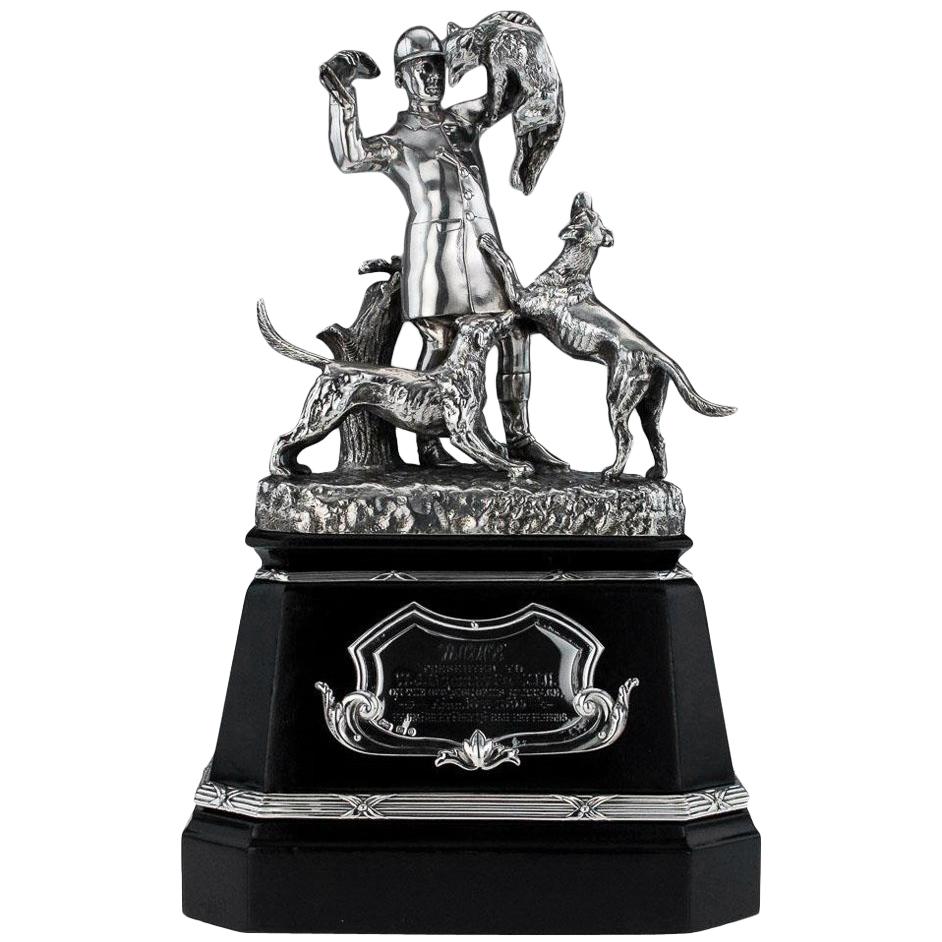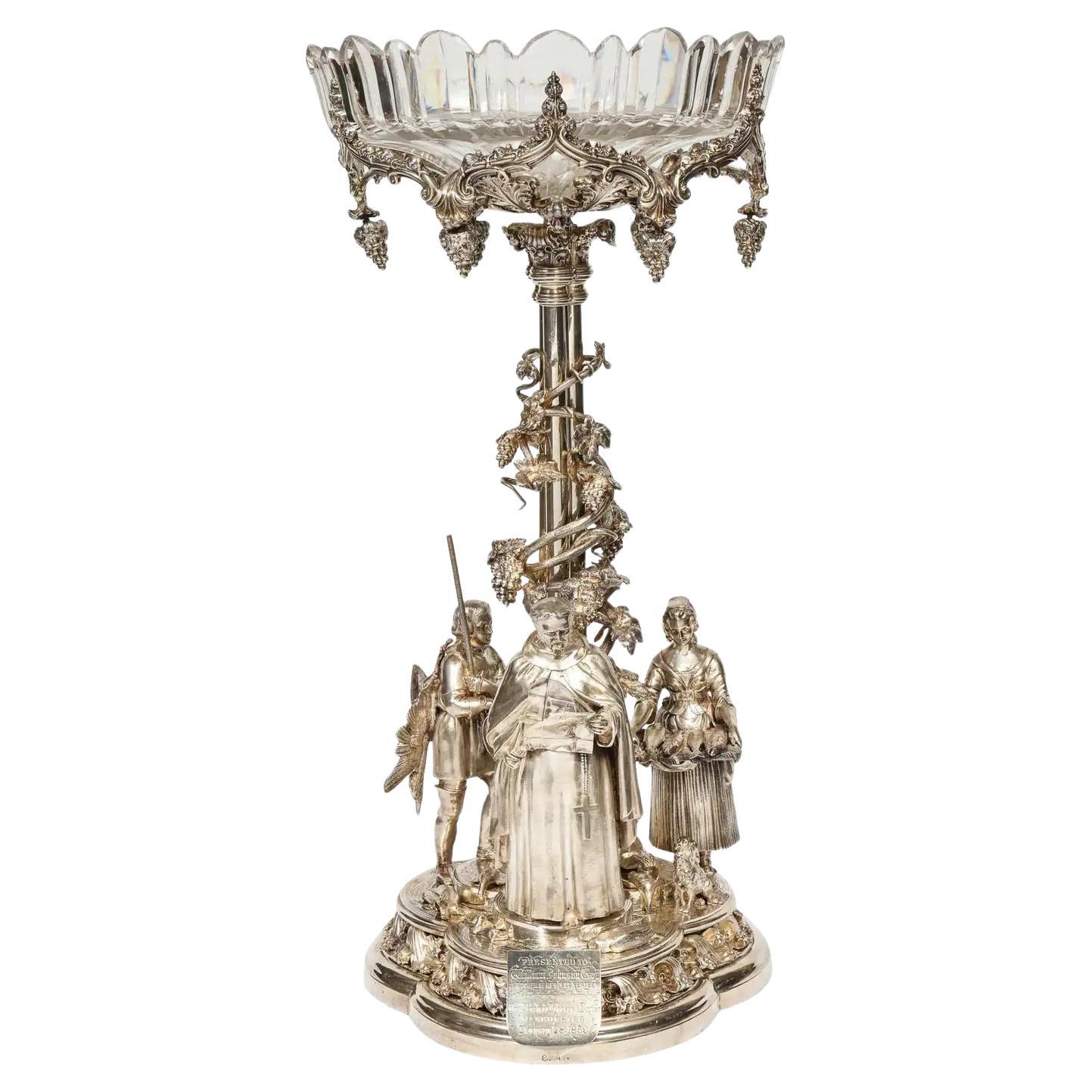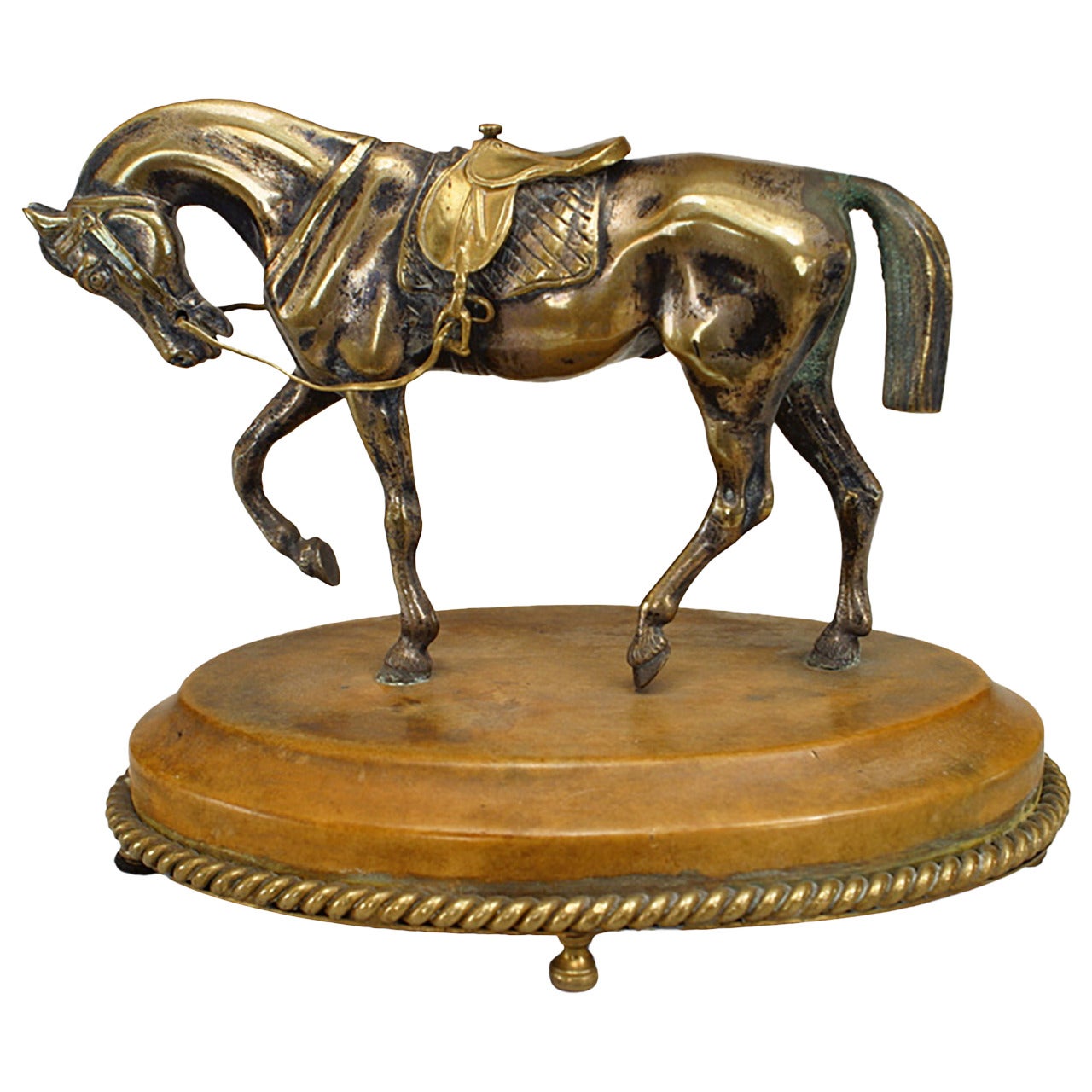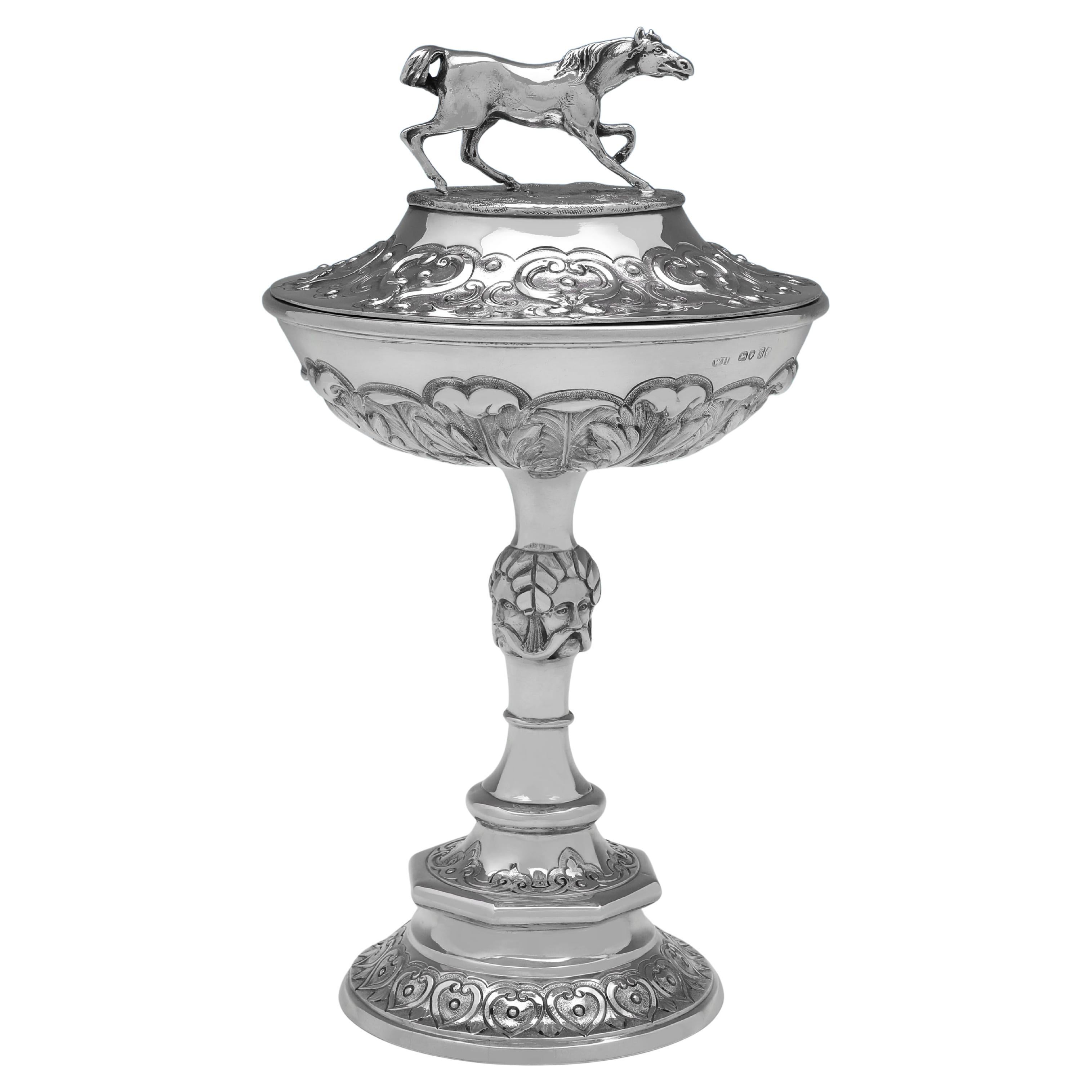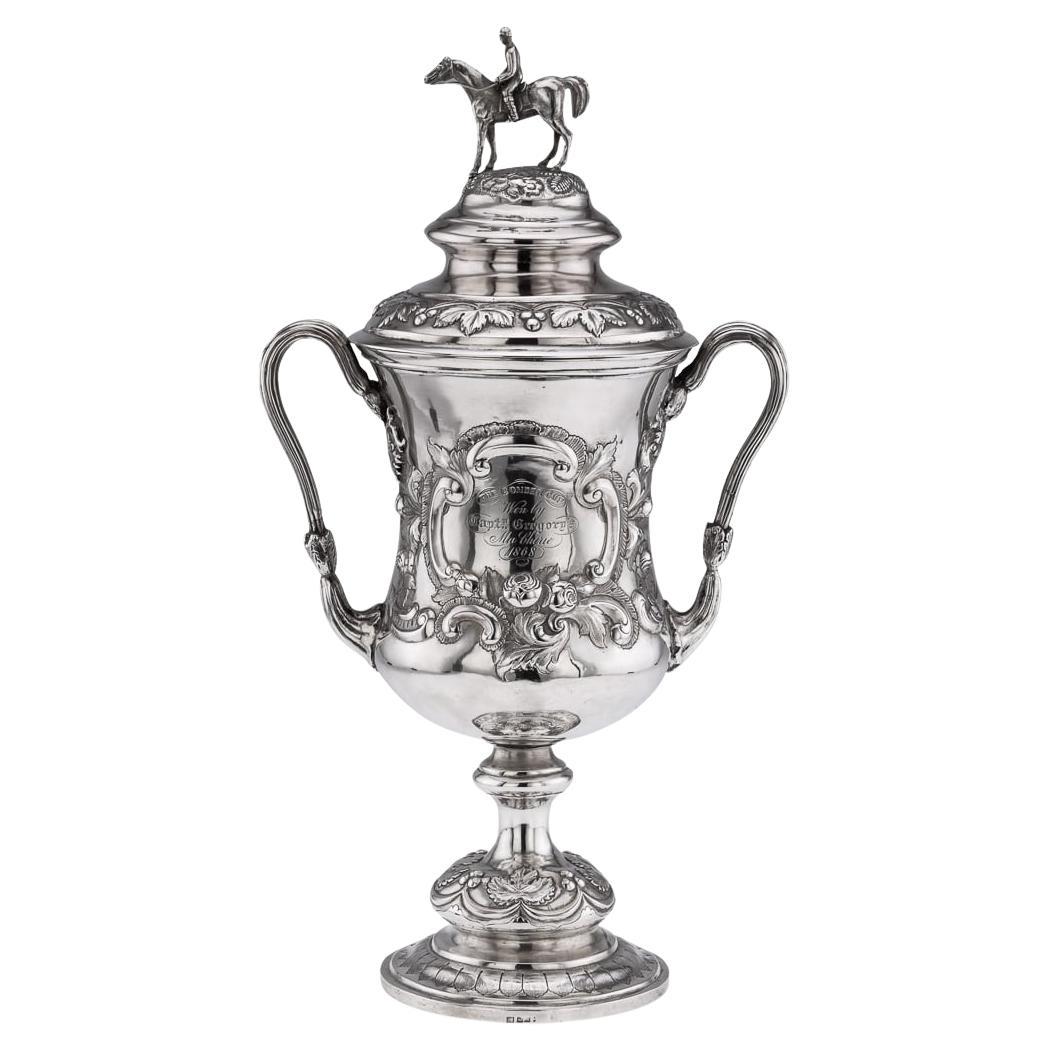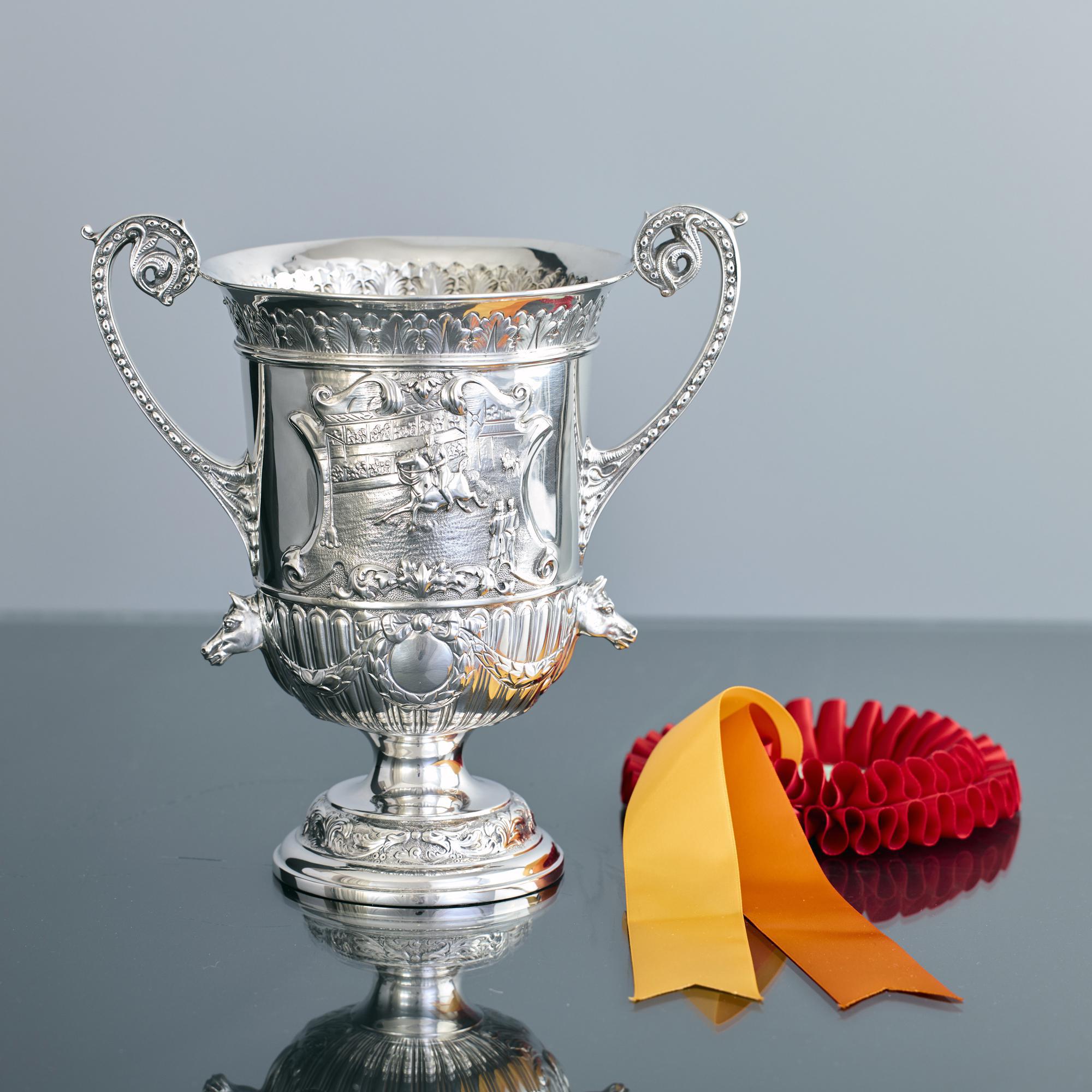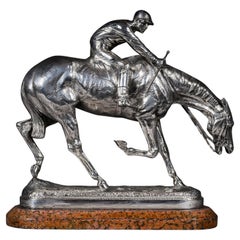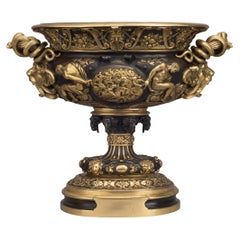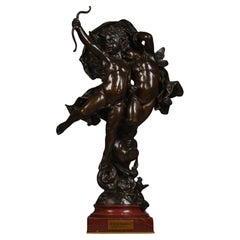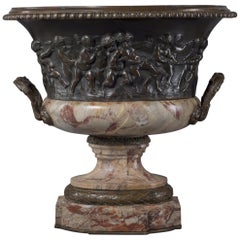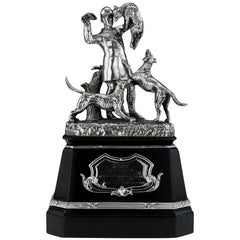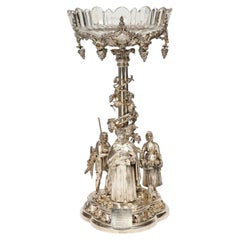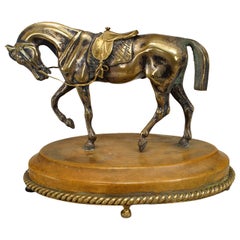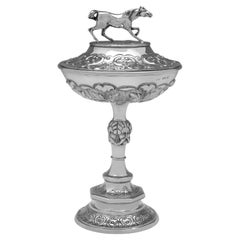Items Similar to 'The Warwick Cup', A Victorian Silver Racing Trophy by Elkington
Video Loading
Want more images or videos?
Request additional images or videos from the seller
1 of 11
'The Warwick Cup', A Victorian Silver Racing Trophy by Elkington
$206,519.54
£150,000
€176,677.47
CA$282,921.44
A$313,925.19
CHF 164,440.77
MX$3,849,565.49
NOK 2,091,629.88
SEK 1,974,409.39
DKK 1,317,594.66
Shipping
Retrieving quote...The 1stDibs Promise:
Authenticity Guarantee,
Money-Back Guarantee,
24-Hour Cancellation
About the Item
The Warwick Cup
An Important Victorian Silver Presentation Horse Racing Trophy For The 1853 Warwick Races, by Elkington & Co. England. Modelled by Pierre-Emile Jeannest (French, 1813 - 1857).
Depicting Queen Henrietta Maria & Prince Rupert of the Rhine At Edge Hill. On a Cornish Sepertine pedestal base set with silver armorial plaques.
Signed 'Executed by Elkington, Mason and Company 1852-1853'. Further hallmarked on foot, cape, and base.
Weight of weighable silver 357 oz. 18 dwt. (11,232 gr.)
Birmingham, England, Circa 1852-1853.
This large and exceptional silver sculpture depicts a finely modelled figure of Queen Henrietta Maria (1609-1669), who was Queen of England, Scotland and Ireland from her marriage to King Charles I on 13 June 1625, until Charles was executed on 30 January 1649. Queen Henrietta-Maria is shown in full dress chased with fleur-de-lys and adorned with jewels, mounted on a horse draped with a latticed blanket. The male figure bowing at her side, his hat resting on the ground, is Prince Rupert of the Rhine (1619-1682). The group is raised on a red Cornish serpentine marble plinth applied with four silver panels depicting medallions of King Charles I and Queen Henrietta-Maria, between the Royal arms of England, the ends embellished with the arms of Prince Rupert of the Rhine.
Provenance
Commissioned from Elkington and Co. by the Warwick Race Committee, 1853. Run for at Warwick Races on Wednesday, 8 September 1853, won by Mr Barber's 3 year old horse 'Goorkah'.
Literature
The Illustrated London News, 'Warwick Race Plate', 10 September 1853, p. 16, column 3, illustrated.
Superbly modelled by the French émigré sculptor Pierre-Emile Jeannest (French,1813 -1857), the group is depicted as an historical ‘tableau vivant’ of the historical meeting during the English Civil War of Queen Henrietta Maria and Prince Rupert at Edge Hill.
Conceived in the chivalric French troubadour style, adapted to the English taste, the group exemplifies the mid-19th century obsession with romantic historicism, as popularised by Sir Walter Scott, and the influence on Jeannest of his teacher, the famed artist Paul Delaroche (French, 1797 - 1856).
Jeannest’s artistic innovation was to translate the dramatic and highly finished style of Delaroche’s history paintings into three-dimensional form. The tense muscularity of the horse with its dramatic flared nostrils and startled openmouthed expression, like a bronze study by Mêne or Barye, contrasting with the dispassionate knowing gaze of Queen Henrietta, as she looks upon the devoted Prince genuflecting to his warrior queen.
From 1851-56, Elkington was commissioned annually to make a series of sculptures as presentation pieces for the Warwick Race Committee, all of which were modelled by Pierre-Emile Jeannest. Drawn from the rich history of the county of Warwickshire, the series included ‘Queen Elizabeth Entering Knebworth Castle, A.D. 1575’, and two scenes, depicting the first pitched-battle of the Civil War in 1642: ‘Charles 1st At Edge Hill’, and the present group ‘Queen Henrietta Maria and Prince Rupert At Edge Hill’.
The Art-Journal of October 1856 acclaimed Jeannest’s History of Warwickshire series, comparing them to Elkington’s famous Iliad Salver:
"The Iliad Salver, although it is the latest, and perhaps the best, of the numerous salvers produced by Messrs. Elkington,is certainly not the only work of the kind which will interest the visitor: there are many others in the Court that will well repay close inspection; so too will the large collection of shields, vases, dishes, candelabra, statuettes, and bronzes of infinite variety, and for useful and ornamental purposes. We would particularly direct attention to the bronze groups, illustrative of Warwickshire History."
On Saturday 21st February, just a fortnight after Jeannest died, the Society of Arts held its first Conversazione of the 1857 season. Elkington contributed twenty-four art works, eleven of which were by Jeannest, in what was seen by many as a mini retrospective. On the Warwick History series, Jeannest’s speciality showpieces, The Journal of the Society of Arts wrote:
"The above three groups are from portions of the history of Warwickshire; and the full-sized groups were made expressly as prizes for the Warwick races, for which several other pieces have been produced by this firm, from models by ‘Jeannest."
The figure of ‘Elizabeth I Arriving At Kenilworth Castle’ the first in the series, was shown at the Great Exhibition of 1851 and was the first work that Elkington commissioned from Jeannest, before employing him full-time two years later. It was highly praised by the Jury and no doubt contributed to him securing a full-time position.
"The Jury have particularly noticed, among the works of Messrs. Elkington and Mason, the beautiful group entirely of cast silver representing Queen Elizabeth on horseback between a gentleman in waiting and a page, after a model executed by M. Jeannest, a French artist. This group is, in the opinion of the Jury, a very choice work of art..."
Whilst at Mintons, Jeannest had designed the “Victoria” pattern dessert-service that Queen Victoria acquired at the 1851 exhibition, and after his appointment at Elkington, Jeannest became a favourite Royal artist.
Victoria and Albert purchased several important works designed by him for Elkington, including a set of twelve candelabra for their new private residence at Balmoral, and the spectacular equestrian silver statue from the Warwick History series, of 'Lady Godiva', purchased by Queen Victoria, and given as a birthday gift to Prince Albert in 1857.
The present group of ‘Queen Henrietta Maria and Prince Rupert at Edge Hill’, was inspired by the famous contemporary portraits of the Queen by artists such as van Dyck and the engravings of Jérôme David (Hieronymus David), showing the Queen on horseback.
The Great Exhibition had created an insatiable enthusiasm for design, but it was the Paris Exposition universelle of 1855 that transformed British design in the late-1850s with a more sophisticated sense of French subtlety and grace, virtues which Elkington capitalised on by the employment of designers such as Jeannest, Willms, and MorelLadeui. Before his untimely death, aged forty-four on 7th February 1857, Jeannest had transformed Elkington’s creative reputation.
His friend, George Wallis, whose tenure as Headmaster of the Government School of Art at Birmingham coincided with Jeannest’s employment by Elkington, wrote his obituary in The Art-Journal, which stressed the key role he played in raising Elkington’s reputation:
"The Jury have particularly noticed, among the works of Messrs. Elkington and Mason, the beautiful group entirely of cast silver representing Queen Elizabeth on horseback between a gentleman in waiting and a page, after a model executed by M. Jeannest, a French artist. This group is, in the opinion of the Jury, a very choice work of art...”
Jeannest’s History of Warwickshire series were, in the 1850s, what Wallis unaffectedly termed “the more important productions of the eminent house,” and were the first masterpieces of the art of electro-metallurgy.
A supreme example of Elkington’s craftsmanship, the sculpture depicts the meeting of Queen Henrietta Maria (1609-1669) and Prince Rupert of the Rhine (1619-1682), the great Civil War military commander and nephew of King Charles I, before the important battle of Edge HIll.
The meeting was notable for its historical significance and the impact that both individuals had on the course of the English Civil War. Prince Rupert's military skill and leadership were critical to the Royalist cause, while Queen Henrietta Maria's political and diplomatic efforts helped to garner support for her husband's reign.
Despite their success on the battlefield, the Royalist cause was ultimately defeated in the English Civil War. Prince Rupert eventually went into exile on the Continent, where he continued to serve in various military capacities. Queen Henrietta Maria also spent time in exile, living in France after her husband's execution in 1649.
At the outbreak of the war Queen Henrietta Maria was at The Hague raising funds for the Royalist army. Following a very rough crossing from the Netherlands she was travelling through England to be reunited with the King. They spent the latter part of 1643 together in Oxford, with the Queen living in the Warden's Lodgings of Merton College.
By March 1644, following a defeat at Alresford, Hampshire, Oxford was deemed to be at risk. The Queen left the city for Bath with the King travelling with her as far as Abingdon. It was the last time they would see each other. Henrietta Maria left England for France via Falmouth on 14 July. The King returned to Oxford with his sons. He continued to fight until 1648 when he was captured and executed the following year.
Henrietta Maria stayed in France under the protection of her family and returned to London after the restoration of her son King Charles II as monarch in 1660, but the damp climate of London caused her to travel to France in 1665 where she remained until her death in 1669. She was buried in the Royal vault of St. Denis, Paris, however, her heart was placed in a silver casket and buried at the convent she founded in Chaillot.
Pierre-Emile Jeannest (1813 – 1857)
The designer and figure-modeller, Pierre-Emile Jeannest (1813-1857) was the son of the French bronzier Louis-François Jeannest (1751-1856) and pupil of the artist Paul Delaroche, professor at the École Nationale Supérieure des Beaux-Arts.
Shortly after turning thirty following the death of his early patron the Duc d’Orléans, the eldest son of Louis-Philippe, he moved to London to seek his fortune. After two years in London mostly spent teaching, he moved to Stoke-On-Trent taking up a position at Minton & Co. where he was employed as a figure modeller, producing designs for majolica, terracotta, parian and porcelain. Whilst at Mintons, Jeannest designed the “Victoria” pattern dessert-service that Queen Victoria acquired at the 1851 Great Exhibition.
Jeannest continued to make occasional designs for Minton after he left to work full time for Elkington in 1853. On 29th September 1853, Jeannest was appointed to “undertake the entire management, care and direction of all French work people” employed by Elkington & Co. His initial term of service was for 4¼ years, at a salary of £450 per annum. This was later adjusted to 5 years at £500 per annum, a considerable annual salary, almost twice that of contemporary doctors and clergy.
A favourite artist of queen Victoria and Prince Albert, they purchased several important works by him, including a set of twelve three-branched candelabra for Balmoral jointly designed by Prince Albert, and the spectacular equestrian silver statue of Lady Godiva, part of the Warwick History series, the second cast of which Queen Victoria gave as a birthday gift to Prince Albert in 1857.
Pierre-Emile Jeannest died at the age of forty-four on 7th February 1857. His work and legacy having transformed Elkington’s reputation.
England, Circa 1852- 1853.
Comparative Literature
Atterbury and Batkin 'Dictionary of Minton' (1990), p. 279.
A Century of Art Education in the Potteries. With notes on the Artists, 1953 Local Studies, 1953 (Circa) p. 6 and p. 44.
The Illustrated London News, 'Warwick Race Plate', 10 September 1853, p. 16, column 3, illustrated.
Alistair Grant, 'Elkington & Co. and the Art of Electro-Metallurgy, circa 1840-1900'.
Thesis, University of Sussex, September 2014.
The Art-Journal, Wallis, George, “Obituary. M. Emile Jeannest,” 1st July 1857, New Series, Volume III, James S. Virtue, London, 1857.
- Creator:Elkington & Co. (Maker)
- Dimensions:Height: 29.53 in (75 cm)Width: 22.05 in (56 cm)Depth: 14.97 in (38 cm)
- Style:Victorian (Of the Period)
- Materials and Techniques:
- Place of Origin:
- Period:
- Date of Manufacture:Circa 1852-1853
- Condition:Wear consistent with age and use.
- Seller Location:Brighton, GB
- Reference Number:Seller: B773301stDibs: LU1028041563162
About the Seller
5.0
Recognized Seller
These prestigious sellers are industry leaders and represent the highest echelon for item quality and design.
Established in 1964
1stDibs seller since 2014
58 sales on 1stDibs
Typical response time: 2 hours
Associations
The British Antique Dealers' AssociationLAPADA - The Association of Arts & Antiques Dealers
- ShippingRetrieving quote...Shipping from: Brighton, United Kingdom
- Return Policy
Authenticity Guarantee
In the unlikely event there’s an issue with an item’s authenticity, contact us within 1 year for a full refund. DetailsMoney-Back Guarantee
If your item is not as described, is damaged in transit, or does not arrive, contact us within 7 days for a full refund. Details24-Hour Cancellation
You have a 24-hour grace period in which to reconsider your purchase, with no questions asked.Vetted Professional Sellers
Our world-class sellers must adhere to strict standards for service and quality, maintaining the integrity of our listings.Price-Match Guarantee
If you find that a seller listed the same item for a lower price elsewhere, we’ll match it.Trusted Global Delivery
Our best-in-class carrier network provides specialized shipping options worldwide, including custom delivery.More From This Seller
View AllJohn Willis-Good, ‘After The Race’, A Silvered Bronze Equestrian Group
By John Willis Good
Located in Brighton, West Sussex
John Willis-Good (British, 1845 - 1879)
‘After The Race’.
A Silvered Bronze Equestrian Group Cast By Elkington & Co, Birmingham.
Depicting a racehorse with jockey up, at the dynam...
Category
Antique 19th Century English Animal Sculptures
Materials
Slate, Bronze
Large Gilt and Patinated Bronze Neoclassical Style Vase, French, circa 1910
Located in Brighton, West Sussex
A large and finely cast gilt and patinated bronze neoclassical style vase.
This impressive vase is of oval shape with gilt and patinated bronze decoration of classical figures and...
Category
Early 20th Century French Neoclassical Vases
Materials
Bronze
'L'Amour Vainqueur' ('A Love Vanquished') By Adolphe Itasse (French, 1830 - 1893
By Adolphe Itasse
Located in Brighton, West Sussex
A Fine Patinated Bronze Figural Group of Cupid and Psyche, Entitled 'L'Amour Vainqueur' ('A Love Vanquished') By Adolphe Itasse (French, 1830 - 1893).
On a revolving rouge de Fran...
Category
Antique 19th Century French Figurative Sculptures
Materials
Marble, Bronze
Louis XVI Style Patinated Bronze and Marble Jardinière after Clodion, circa 1870
By Claude Michel Clodion
Located in Brighton, West Sussex
A Louis XVI style patinated bronze and marble jardinière, cast in relief with Bacchanalian Scenes Of Putti at Play, After Clodion.
French, circa 1870.
The body of the jardiniè...
Category
Antique Late 19th Century French Louis XVI Planters and Jardinieres
Materials
Marble, Bronze
'Bacchantes', a Fine Patinated Bronze Figural Group After Clodion, circa 1870
By Claude Michel Clodion
Located in Brighton, West Sussex
'Bacchantes', a fine patinated bronze figural group after Claude Michael Clodion, French (1738-1814).
French, circa 1870.
Signed 'Clodion' to the base and inscribed 'BACCHANTE...
Category
Antique Late 19th Century French Figurative Sculptures
Materials
Bronze
François Truphème (1820 -1880) - 'Moses and Jochebed'
By François Truphème, Thiebaut Freres
Located in Brighton, West Sussex
'Moses and Jochebed - A Fine Patinated Bronze Figural Group After A Model by 'François Truphème', Cast by 'Thiebaut Frères'.
Signed 'Fois Truphème 1863' and 'fdu par Vor Thiebaut'....
Category
Antique Mid-19th Century French Figurative Sculptures
Materials
Bronze
You May Also Like
19th Century Victorian Solid Silver Hunting Trophy, Elkington, circa 1894
By Elkington & Co.
Located in Royal Tunbridge Wells, Kent
Description:
Antique 19th century Victorian solid silver important figural hunting statue, dipicting a huntsman holding a fox and his hounds at his ...
Category
Antique 19th Century English Victorian Figurative Sculptures
Materials
Sterling Silver
A Rare 1859 Elkington Silvered Bronze Victorian "Trophy" Centerpiece
By Elkington Mason & Co.
Located in Queens, NY
A Rare and Historic 1859 Elkington Silvered Bronze Victorian Centerpiece with Cut-Glass Bowl.
Presenting a magnificent Victorian silvered bronze centerpiece of unmatched rarity and importance, crafted by the renowned Elkington Mason & Co., Birmingham, in 1859. This exceptional work, complete with its original cut-glass bowl, epitomizes 19th-century British craftsmanship and artistry. Hallmarked to the base, this centerpiece showcases intricate sculptural details, embodying a high level of technical prowess and aesthetic refinement characteristic of Elkington's celebrated works.
The centerpiece's striking design features three meticulously rendered figures—a young hunter, a friar, and a fishmonger—each embodying elements of Victorian life and industry. At their feet, a loyal spaniel and various game highlight the naturalistic approach to the composition, enhanced by the masterful chasing and dynamic form. This sculptural ensemble rests on an elaborately decorated base, exuding both grandeur and narrative depth.
Adding profound historical value are two engraved plaques. The first, dated “January 28, 1859,” reads: “Presented to William Johnson Esq. as a token of respect & esteem by the workpeople in the employ of Messrs Richard Johnson & Brother, Manchester.” The second, an inscription from 1941, states: “Worshipful Company of Tin Plate Workers, Alias Wire Workers of the City of London, Presented by Arthur Laurence Johnson M.A., Grandson of William Johnson, both Wire Workers, with his Daughter Eleanor Morton Johnson, a Freeman of the Company, to commemorate his Mastership 1941-42.”
These inscriptions chart a rich lineage, connecting the Johnson family to pivotal moments in industrial history. William Johnson, alongside his brother Richard, assumed leadership of a wire-drawing firm in 1838, which would later become Richard Johnson & Nephew Ltd. Their contributions included providing galvanized armored wire for the historic 1857 transatlantic telegraph cable...
Category
Antique 19th Century British Victorian Centerpieces
Materials
Metal, Bronze
Victorian Silver Bronze Racing Horse
Located in Queens, NY
English Victorian silver plated bronze figure of racing horse with saddle on a yellow oval marble base with bronze trim
Category
Antique Late 19th Century British Victorian Animal Sculptures
Materials
Marble, Silver Plate, Bronze
Antique Victorian sterling silver horse trophy made in London in 1865
By William Hunter
Located in London, London
Hallmarked in London in 1865 by William Hunter, this attractive, Antique, Victorian Sterling Silver Trophy, is ornate in design and has a horse finial. The trophy measures 11"(28cm) ...
Category
Antique 1860s English Victorian Sterling Silver
Materials
Sterling Silver
Antique 19th Century Indian Colonial Solid Silver Trophy Cup & Cover c.1860
By Charles, Nephew & Co. 1
Located in Royal Tunbridge Wells, Kent
Antique 19th Century Indian Colonial solid silver trophy cup and cover, exceptionally heavy and decorative, campana form on a spreading foot, domed lid chased and embossed with folia...
Category
Antique 19th Century Indian Other Centerpieces
Materials
Silver
Unusual Victorian silver equestrian trophy vase
By Carrington & Co
Located in London, GB
Unusual antique two-handled silver trophy cup with cast and hand chased detail including a cavalry horse riding scene depicting a competition of horsemanship inside an arena. There i...
Category
Antique Late 19th Century British Art Deco Historical Memorabilia
Materials
Sterling Silver
More Ways To Browse
Antique Trophies
Antique Bronze Cup
Antique Cup Plates
Victorian Cup
Large Antique Trophy
Black Victorian Dress
Antique Prince Albert
Trophy Cup
Used Office Furniture Oxford
Dessert Cups Silver
Trophy Vase
Antique Key Heart
The Four Seasons 19th Century
Antique Silver Trophy
Horse Cup
Victorian Bath
Trophy Silver Cup
Used Adjustable Dress Form
